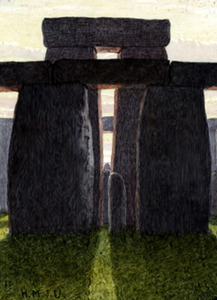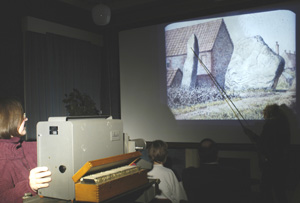HMJ Underhill Archive
Deborah Harlan, Megan Price, 2004. (updated 2013) https://doi.org/10.5284/1000234. How to cite using this DOI
Data copyright © University of Oxford unless otherwise stated
This work is licensed under the ADS Terms of Use and Access.
Primary contact
Prof
Helena
Hamerow
Institute of Archaeology
University of Oxford
36 Beaumont St
Oxford
OX1 2PG
England
Tel: 01865 278240
Fax: 01865 278254
Resource identifiers
- ADS Collection: 395
- DOI:https://doi.org/10.5284/1000234
- How to cite using this DOI
Overview
Information | Background | HMJ Underhill | Slides | Bibliography | About
H M J Underhill

Life & Times
Henry Michael John Underhill was born in Oxford in 1855. He was the eldest son of Henry Scrivener Underhill, the proprietor of a 'High Class Grocer to Gentlemen of the University' in the High Street. The Underhills were a prominent city family; many of them became Liberal Mayors or Aldermen of Oxford. This was at a time when the city council was beginning to exert its independence from the University and the city experienced both economic and population expansion. The Underhills were members of the Congregational church. As an adult, Henry Underhill was involved with the children's temperance movement, The Band of Hope, and regularly took classes, produced plays, gave lantern shows and organized children's games.
In many ways, Henry Underhill was a product of his age. He was a gifted amateur, a participator in the changing attitudes during the latter half of the nineteenth century towards technological and scientific discovery. He was able to record meticulously his observations from nature using the latest scientific equipment as it became widely available to the public. While still in school, Henry Underhill showed artistic promise and was given lessons from the painter, William Rivière (1806-1876). Underhill's sketchbooks are now in the Oxford University Museum of the History of Science and show his early interest in microscopy and entomology. In his early twenties, as a member of the Postal Microscopy Club, he wrote several articles (some with his cousin Frank Allen) for the popular science magazine Hardwick's Science-Gossip. These articles were illustrated with his detailed drawings of flies and spiders drawn from direct observation and the microscope.
As the eldest son of a business owner, his future as a shop owner was probably prescribed for him. Despite his academic and scientific leanings, Henry Underhill's interest remained on an amateur level. It may be also that as a non-conformist he was still ineligible in the 1870s for entry into the University. On the other hand, his younger brother, George Edward, was able to study classics at Oxford and became a fellow of Magdalen College.
In the second half of the nineteenth century many scientific societies were being formed nationally. In Oxford, these societies allowed interested townsfolk to interact with academics on a scholarly level. Because of his interest in Natural History, Underhill became a founding member of the Oxfordshire Natural History Society and Field Club (later to become the Ashmolean Natural History Society). This society was formed in 1880 and met regularly at the University Museum. This was an appropriate venue for this society as it was the setting for 'The Great Debate' in 1860 between Thomas Huxley, a scientist and supporter of Darwin's theories of evolution, and Bishop Samuel Wilberforce, an advocate of the traditional Biblical account of Creation and Natural Theology.
From the 1880s to the 1890s, Underhill was an active member of the Oxfordshire Natural History Society, as Secretary, Treasurer and finally President in 1893. His first lectures to the Society were on Natural History: 1887 Spiders, 1888 Insect Eyes and 1889 on Microscopic Organisms from Ponds. By the late 1880s, Underhill began producing hand-painted Magic Lantern Slides on broader topics. His slides of folktales were shown during entertainments for the Oxford Ragged School, the Congregational Church Sunday School and The Band of Hope. From 1897, much of his leisure time was devoted to the Oxford Camera Club.
In 1914, the outbreak of the First World War threw the country into economic decline and affected both the University and the City of Oxford. Underhill's business in the High Street began to suffer. However, he continued to photograph buildings and landscape during outings with family and friends to local places of interest. Some of his last photographs in 1919 show views of Wayland's Smithy and the White Horse at Uffington.
On October 2nd 1920, after a long illness, Henry Michael John Underhill died, age 65, unmarried. He is buried with his mother, father and sister Maud in the Wolvercote Cemetery, Oxford. Throughout his adult life, Underhill retained his wide interests. The painted slides and photographs he created for lectures to various societies and children's entertainments reflect his gift for observation of minute detail and painstaking, meticulous documentation of subjects.
The Antiquarian Corpus of H.M.J. Underhill

The production of Henry Underhill's hand-painted slides date from c. 1887-1895. The focus of the slides chronologically follow three successive themes: Natural History, folklore, and British prehistoric and industrial archaeology. He was inspired by drawings from contemporary books, works of art, photographs and his observations of nature. In some cases, he documented his sources on the slide captions or made notes in his sketchbooks. For his original work, he initialled and often dated the slide.
Like many Natural History Societies founded in the second half of the nineteenth century, the members of the Oxfordshire Natural History Society took a keen interest not only in the 'natural' history but also in the 'ancient' history of the landscape. Underhill organised regular excursions to archaeological sites in the area such as Uffington White Horse, Wayland's Smithy and the Roman Villa at North Leigh near the Stonesfield Quarry (significant for its fossils).
From the mid-1890s, Underhill's interest revolved around British antiquities. During the spring of 1895, he painted numerous slides of Roman remains in the cities of Silchester, Colchester, Wroxeter and the villa at North Leigh. Later that year, during the annual conference of the Midland Union of Natural History Societies, hosted by the Oxford club, Underhill organised an excursion to Stonesfield Quarry and North Leigh villa. The preceding evening, he had addressed the conference showing these slides entitled Some Buried Roman Cities.
During the winter of 1895, Underhill painted slides for a talk on The Great Stone Circles of Britain. These were based on original photographs and sketches he had made earlier in the year. A few of the slides are copies of maps and plans taken from publications. The lecture was delivered in February 1896 in the University Museum with many distinguished scholars in attendance including Professor Poulton, the Hope Professor of Entomology, and Mr Arthur Evans, the Keeper of Antiquities at the Ashmolean Museum. According to an account in the Oxford Chronicle a long and interesting discussion ensued.
In 1907, Underhill completed a photographic study of Windmills for a project coordinated locally by the Oxford Architectural and Historical Society (with members of the Natural History Society and the Oxford Camera Club participating). The windmill photographs, photographic albums and slides are now in various Oxford archives. These photographs today provide a source for industrial archaeologists as many of the structures no longer exist. During this time, he also painted one last set of slides on Windmills, some of them using books and manuscripts from the Bodleian Library.
The chance re-discovery of the Underhill slides at the Institute of Archaeology has brought this nineteenth century grocer, entomologist and antiquarian back into the limelight.
Henry Underhill and the Magic Lantern in Oxford

H.M.J. Underhill was both a photographer and a lantern showman. His uniqueness, however, lies in his beautiful hand-painted slides and his choice of subjects. He was both an entertainer, showing his beautiful fairy-tale slides to rapt audiences of children, and a specialist speaker delivering illustrated lectures to the members of learned societies. The sets of H.M.J. Underhill slides owned by the Institute of Archaeology were delivered to learned societies with both academic professionals and educated amateurs in the audience.
In the later 19th century, educational slides produced by educators (as opposed to the commercial sets) were commonly used in lectures. There is ample evidence from lecture lists of various learned societies in Oxford such as the Oxfordshire Natural History Society of which Underhill was a founding member that "Oxy-hydrogen limelight" was used to project the lecturers' own unique slides. By the first decade of the 20th century, the Society (now named the Ashmolean Natural History Society) had compiled their own lending lantern slide collection based on donations from their members. Catalogues and some of the slides from this collection are now in the Oxford University Museum of the History of Science. The 1907 lantern slide catalogue was also published in Frank Bellamy's book A History of the Ashmolean Natural History Society (1908) complete with donor names.
Also, in the late 19th century, Extension Courses (forerunner of the Department of Continuing Education at Oxford), which provided lectures by academics to non-University audiences, were often illustrated using lantern slides. In the two articles Underhill published, one in 1890 on "Painting Lantern Slides Direct from the Microscope" and the second in 1892 on "Artistic Lantern Slides", he mentions a University Extension lecturer friend who, out of necessity, hand-painted slides for scientific detail which could not be acquired by purchased photographic slides as these were often photographs of black and white drawings and were of inferior quality. The same recommendation is made for microscopic illustrations. However, for recording other subjects, the photograph was deemed to have its place. For the presentations of the Great Stone Circles, Buried Roman Cities and Windmills, Underhill chose to hand-paint his subjects on slides from direct observation and sketches, from personal photographs, and from published maps and plans.
After the slides for Great Stone Circles, Buried Roman Cities and Windmills came to Oxford University, they were used in academic teaching. However, by the time the glass slide was becoming obsolete, the collection had nearly been forgotten. Today, there is an emerging intellectual interest in the history and use of lantern slides. Many institutions are opening closets to find stores of glass slides and developing an interest in studying them. H.M.J. Underhill's slides presented here, in addition to showing subjects of archaeological significance, are artefacts with a history of their own.





